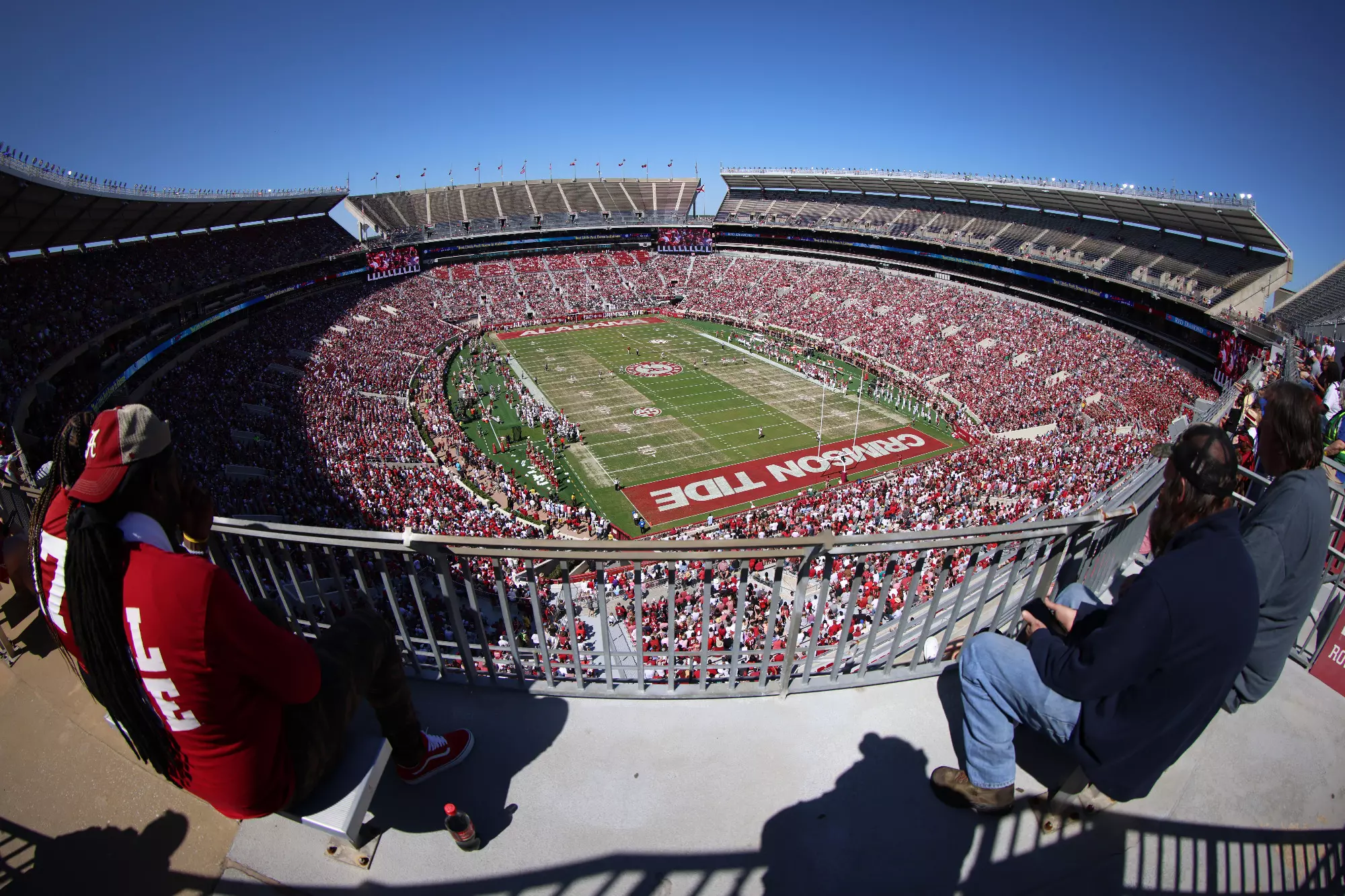In 2025, the University of Alabama’s A-Day spring football event underwent a significant transformation, shifting from its traditional spring game format to an open practice. This change was prompted by concerns over player safety, particularly regarding injuries and the impact of the transfer portal. The decision marked the fourth time since 1946 that Alabama did not hold its customary spring game .(saturdaydownsouth.com, rollbamaroll.com)
The modified A-Day event drew an estimated 10,000 to 15,000 fans to Bryant-Denny Stadium, a notable decrease from the over 72,000 attendees the previous year . This decline in attendance reflects broader trends in college football, where many programs are reevaluating the necessity and format of spring games.(saturdaydownsouth.com)
Tuscaloosa Mayor Walt Maddox, who has served the city since 2005, expressed support for the decision to scale back A-Day. He noted that, from the city’s perspective, focusing on University of Alabama-generated events that require less logistical support and security personnel would be more beneficial. Maddox acknowledged that his stance had evolved over time, stating that while he would have supported A-Day two decades ago, the current circumstances make it a more practical choice to forgo the event .(saturdaydownsouth.com, rollbamaroll.com)
This perspective aligns with national trends, as many college football programs are reconsidering the necessity of spring games. The shift away from traditional spring games reflects a broader reevaluation of college football’s offseason events and their impact on player safety and program logistics.(collegefootballnetwork.com)
In summary, the 2025 A-Day event at the University of Alabama marked a departure from tradition, with a reduced attendance and a shift in format. Mayor Walt Maddox’s support for this change underscores the evolving priorities in college football, balancing tradition with the practical considerations of modern-day athletics.(saturdaydownsouth.com, twitter.com)
The University of Alabama’s decision to scale back A-Day, traditionally one of college football’s most anticipated spring games, has stirred conversations not only among fans but also city officials, local businesses, and the broader college football community. For decades, A-Day has served as both a showcase for Crimson Tide talent and a beloved ritual for fans to reconnect with the program during the offseason. However, evolving concerns around player safety, shifting priorities, and logistical challenges have forced a reevaluation of what A-Day means and how it should be held moving forward.
Tuscaloosa Mayor Walt Maddox, a key voice in this dialogue, offers an insightful perspective shaped by years of observing the event’s impact on the city. While Maddox admits that he once was a staunch supporter of the traditional A-Day format, his views have shifted over time. He now acknowledges that the demands placed on city infrastructure, public safety resources, and local traffic management during A-Day weekends can be considerable, especially as the event draws tens of thousands of attendees.
From the city’s standpoint, balancing enthusiasm for the Crimson Tide with the practical realities of hosting such a massive crowd has become increasingly complex. Maddox points out that the expenses associated with police presence, emergency services, traffic control, and sanitation efforts during A-Day often stretch the city’s budget and personnel. This is particularly relevant as the city juggles other pressing priorities, including economic development, housing, and education initiatives.
In addition, the change in A-Day’s format reflects a broader national trend within college football. Programs across the country are reevaluating spring games’ roles amid concerns over player injuries, coaching staff workloads, and shifting fan engagement patterns. Some programs have opted to cancel or drastically scale back spring games altogether, viewing them as less critical to team development than in years past.
One significant factor influencing Alabama’s decision is the ongoing transfer portal’s effect on team dynamics. With more players transferring in and out of programs each offseason, coaches face the challenge of integrating new talent while managing existing rosters. This fluidity makes it difficult to maintain a consistent, full roster for a highly competitive spring game. By holding open practices rather than traditional games, coaching staffs can focus on player development without the added pressure and risk of game-like competition.
Moreover, concerns about player health are front and center. The NFL and college football leagues have increasingly emphasized the importance of protecting players from avoidable injuries, and spring games have come under scrutiny for potentially exposing athletes to unnecessary risks. By reducing the intensity and physicality of spring events, programs aim to safeguard their players as they prepare for the rigorous fall season.
The fans’ response to the new A-Day format has been mixed. While attendance dropped to roughly 10,000–15,000 from the usual tens of thousands, many fans appreciate the more intimate and family-friendly atmosphere that the open practice creates. Without the high-stakes competition of a game, attendees can focus on watching drills, player interactions, and coaching sessions, offering a unique behind-the-scenes experience.
However, some fans express disappointment at the loss of the traditional spectacle. For many, A-Day represented more than just a spring game — it was a social event, a tradition, and a symbol of Crimson Tide pride. Tailgates, marching band performances, and fanfare created a festive environment that brought the community together. The absence of this larger-scale event leaves a void that some feel has yet to be fully filled.
Local businesses, which historically benefited from the influx of visitors during A-Day weekend, are also adjusting to the changes. Hotels, restaurants, and retailers saw a decline in patronage compared to previous years, forcing some to reconsider how they approach the spring season. On the other hand, some local entrepreneurs see an opportunity to innovate by creating smaller-scale events and experiences that complement the open practice format and draw visitors in different ways.
Mayor Maddox notes that the city continues to support the University of Alabama’s football program wholeheartedly. The Crimson Tide remains a central pillar of Tuscaloosa’s identity and economy. Yet, he emphasizes the importance of aligning community interests with the realities of hosting such large-scale events. Maddox advocates for a balanced approach that allows the university to showcase its football talent while ensuring that city resources are managed prudently and residents’ quality of life is preserved.
Looking ahead, the future of A-Day remains uncertain but full of potential. The university and city leaders are exploring various options that could reinvigorate the event while addressing current concerns. Ideas under consideration include hybrid formats that combine open practices with limited competition, enhanced fan engagement through technology and interactive experiences, and partnerships with local businesses to create a more integrated event ecosystem.
One emerging concept involves leveraging digital platforms to bring A-Day content to fans unable or unwilling to attend in person. Streaming open practices, conducting player interviews, and sharing exclusive behind-the-scenes footage could broaden the event’s reach and maintain fan enthusiasm. Additionally, community-centric activities such as youth football clinics, fan festivals, and charity events might complement the football activities to create a richer, more inclusive experience.
The changing landscape of college athletics, including evolving media rights deals, NIL (Name, Image, and Likeness) opportunities for players, and heightened awareness of player welfare, also plays into how spring events like A-Day might evolve. The University of Alabama, with its deep-rooted tradition and national prominence, is well-positioned to pioneer innovative approaches that set a new standard for spring football celebrations.
Ultimately, A-Day’s transformation reflects the dynamic interplay between tradition and progress. While the nostalgia for packed stadiums and intense spring matchups remains strong, the realities of modern sports demand flexibility and foresight. Mayor Walt Maddox’s endorsement of a more measured A-Day is emblematic of a pragmatic approach that respects both the past and the future.
In conclusion, Alabama’s A-Day is at a crossroads. Its legacy as a beloved spring game faces challenges from logistical, safety, and cultural shifts. Yet, through thoughtful collaboration between the University of Alabama, city officials like Mayor Maddox, and the wider community, A-Day can adapt and thrive in new ways. Whether through scaled-back events, digital innovations, or expanded fan experiences, the spirit of A-Day will continue to unite Crimson Tide fans and Tuscaloosa residents for years to come.
If you’d like, I can help craft a closing paragraph or polish it further! Would you want more detailed quotes from the mayor or additional context about Alabama football traditions?



